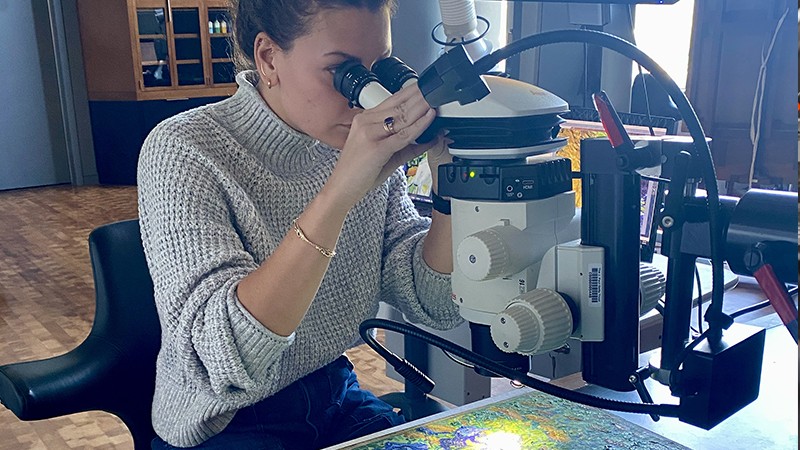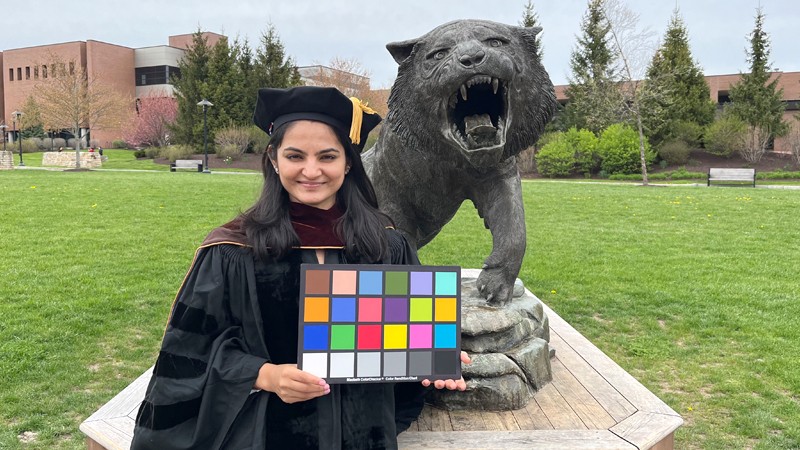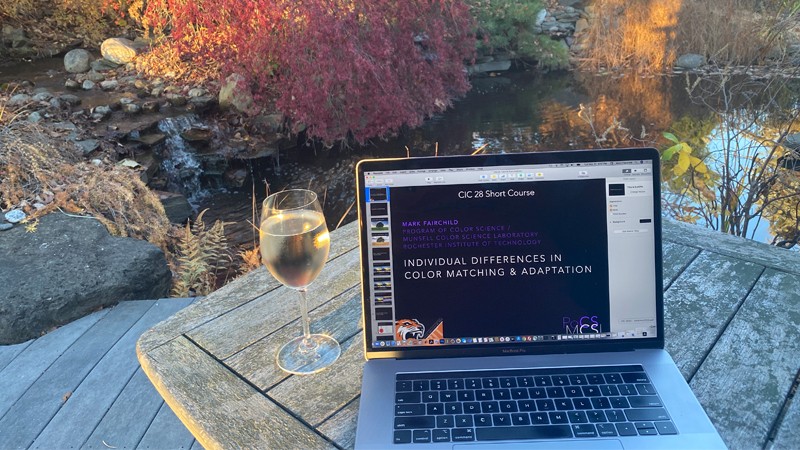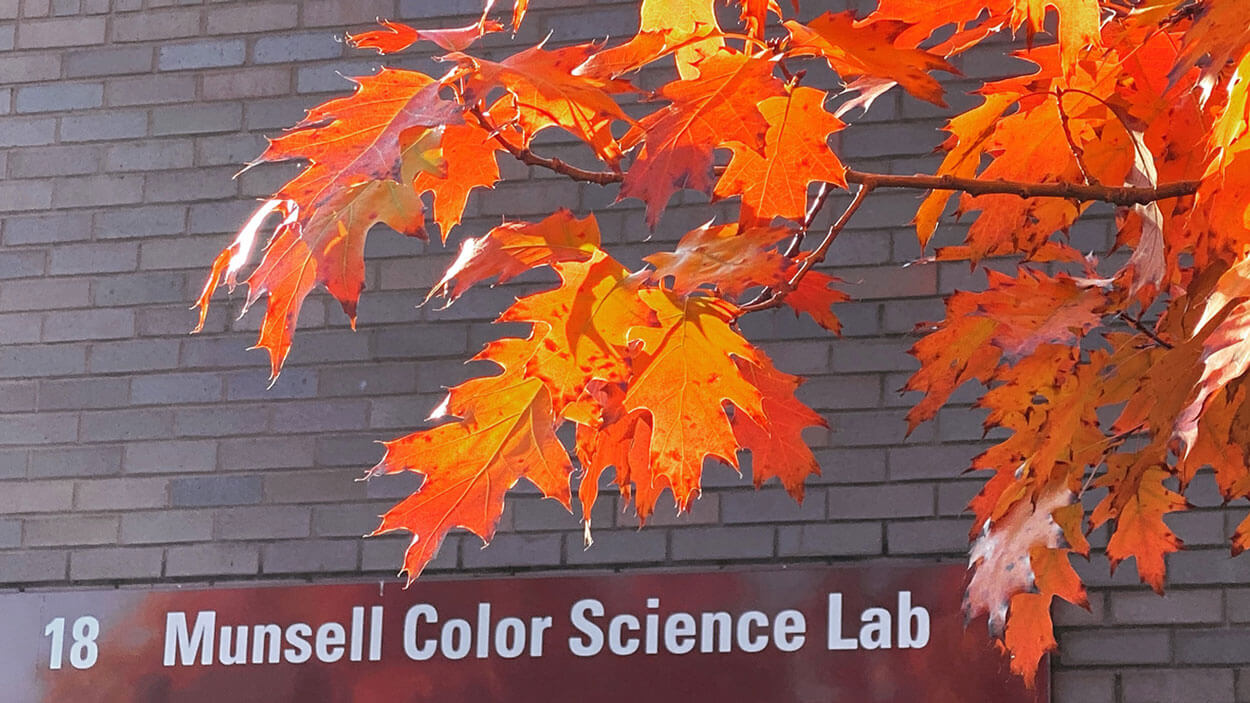Color Science Doctor of Philosophy (Ph.D.) Degree

Color Science
Doctor of Philosophy (Ph.D.) Degree
- RIT /
- Rochester Institute of Technology /
- Academics /
- Color Science Ph.D.
Overview for Color Science Ph.D.
Color has been an intense topic of interest for thousands of years. Mathematicians, philosophers, physicists, physiologists, poets, and other disciplines have all contributed to our understanding of color. RIT’s color science Ph.D. program allows you to contribute to knowledge creation and practical application of color science. You will conduct extensive research that encompasses diverse fields and multiple disciplines of science.
As a generalization, color science can be defined as the quantification of our perception of color. Its mastery requires a multidisciplinary educational approach encompassing physics, chemistry, physiology, statistics, computer science, neuroscience, and psychology. Color science is used in the design and control of most man-made colored materials including textiles, coatings, and polymers and to specify such diverse materials as soil and wine. It is used extensively in color reproduction including digital photography, desktop and projection display, and printing. Color science is ubiquitous.
The program is designed for students whose undergraduate degrees are in physics, biology, chemistry, mathematics, computer science, engineering, neuroscience, experimental psychology, imaging, or any applied discipline pertaining to the quantitative description of color, for example, textiles, graphic arts, animation, material science, and polymer science. All students must earn 60 credit hours as a graduate student. For full-time students, entering with a baccalaureate degree, the program requires about four years of study at the graduate level.
Plan of Study
The curriculum is a combination of required courses in color science, elective courses appropriate for the candidate’s background and interests, a research project during the second year of study, and a research dissertation. Students must pass a qualifying examination during their second year of study and a candidacy examination at least one year prior to completing their dissertation. Candidates who wish to enter the program, but lack adequate preparation, might be required to complete undergraduate foundation courses in mathematics, statistics, computer science, and general science before matriculating with graduate status.
Core courses
The following core courses are completed during the first year of study: Principles of Color Science, Computational Vision Science, Color Physics and Applications, Modeling Visual Perception, Historical Research Perspectives, and Research and Publication Methods.
Electives
Elective courses are selected depending on the student’s interests and background. The program director must approve all electives.
Second year project
During the second year, students engage in graduate-level research under the supervision of a graduate program faculty member. The topic may or may not be the same as the dissertation topic. One of the purposes of this project is to evaluate the student’s research capabilities and suitability for doctorate-level research.
Years three and beyond
After completing the required courses, students follow their study plan which consists of research and thesis credits and elective courses.
Qualifying examination
All students must pass a qualifying examination, which determines whether the student has a sufficient depth of knowledge in color science and the ability to perform research at the doctoral level.
The qualifying exam consists of a written test and an evaluation of the second-year research project. The written test is given twice each year and is based on the core curriculum in color science and any material deemed appropriate by the committee. Note that the required readings for these courses include textbooks and current literature. An evaluation of the second-year research project includes depth of research, productivity, quality, analytical skills, and the ability to communicate results. A written document is submitted in the style of a published proceedings paper.
Students must successfully pass the qualifying examination to continue in the program. Those who do not pass the qualifying examination may make a written request to the color science program director to change to the MS program. Requests must be received before the end of the semester in which the second written test is taken. Students with permission to enter the MS program will use their second year research project as an MS research thesis topic. A written thesis is required. Students can then graduate with an MS in color science.
Dissertation research advisor and committee
After students pass the qualifying examination, a dissertation research adviser is selected from the graduate program faculty based on the student’s research interests, faculty research interests, and discussions with the color science graduate coordinator. A four-member dissertation committee is appointed for the duration of the student’s tenure in the program. The committee includes the dissertation research advisor, one other member of the color science faculty, and an external chair appointed by the dean of graduate education. The external chair must be a tenured member of the RIT faculty who is not a current member of the color science faculty. The fourth member may be an RIT faculty member or a professional affiliated with industry or another institution. The color science graduate program director must approve committee members who are not RIT faculty.
The dissertation committee prepares and administers the examination for admission to candidacy; assists in planning and coordinating research; provides research advice; supervises the writing of the dissertation; and conducts the final examination of the dissertation.
Developing a study plan
During the first semester of study, students work with the color science graduate program director to develop a study plan. This plan may be revised as necessary, subject to approval by the graduate program director. For example, the dissertation research adviser or the dissertation committee might recommend a revised study plan to include specific graduate electives.
Admission to candidacy
When the student thoroughly understands the dissertation research topic, the dissertation committee administers an examination to determine if the student can be admitted to candidacy for the doctoral degree in color science. The purpose of the examination is to ensure the student has the necessary intellectual skills and background knowledge to carry out their specific doctoral-level research project. The dissertation research adviser defines the type of examination and any requirements prior to the examination. Requirements include a dissertation proposal and may additionally include a review of literature, preliminary experiments, and the preparation of an oral presentation. The examination must be administered no later than one year prior to defending the dissertation.
Final examination of dissertation
Once the dissertation has been written, distributed to the dissertation committee, and the committee agrees to administer the final examination, the doctoral candidate can schedule the final examination.
The final examination of the dissertation is open to the public and is primarily a defense of the dissertation research. The examination consists of an oral presentation by the student, followed by questions from the audience. The dissertation committee may also elect to privately question the candidate following the presentation. The dissertation committee immediately notifies the candidate and the color science graduate program director of the result of the examination.
Teaching experience
All candidates for the Ph.D. must serve as a teaching assistant for a minimum of one course before scheduling the final examination of the dissertation. Candidates are encouraged to serve as a teaching assistant for two or more courses.
Public presentation experience
All candidates for the Ph.D. must present research in a public forum before scheduling the final examination of the dissertation. The preferred public forum is a technical conference.
Publication requirement
Prior to scheduling the Ph.D. dissertation defense (final examination), all candidates for the Ph.D. must have at least two refereed journal publications on the dissertation research accepted for publication (or published). The student must be a principal (not always first) author on both papers.
Color science MS graduates
Graduates from the color science master's degree program, who are interested in the doctoral program, should contact the color science graduate program director to discuss their suitability for doctoral-level research. Before matriculating into the program, students must pass the qualifying examination. Once the examination has been passed successfully, students can be admitted into the doctoral program. The doctoral degree can be completed on a full- or part-time basis as long as the residency requirements are met.
MS and MA graduates from related disciplines
Because of the interdisciplinary nature of color science, students with MS and MA degrees often apply to the Ph.D. program. Graduate courses in related disciplines can be used as elective courses toward the degree. Furthermore, for degrees that required a research thesis, the second year research project might be waived. Thus, it might be possible for students with graduate degrees in a related discipline to take the qualifying examination during their first year of study. The color science graduate program director determines the specific courses and credit hours that can be applied toward the Ph.D. in color science.
Residency
All students in the program must spend at least two consecutive semesters (summer may be excluded) as resident full-time students to be eligible to receive the Ph.D.
Time limitations
All candidates for the Ph.D. must maintain continuous enrollment during the research phase of the program. The maximum number of research credits that apply to the degree does not limit such enrollment. Normally, full-time students complete the course of study for the doctorate in approximately four years. Requirements for the degree must be completed within seven years of the date students pass the qualifying examination.
-
Meet us on-campus on February 19
Learn about the programs that interest you. Hear from program faculty, speak with current graduate students, and ask the questions that will help you get one step closer to your career goals.
Research
Research conducted in the color science doctorate program revolves around the activities of the Munsell Color Science Laboratory, which is the pre-eminent academic laboratory in the country devoted to color science. Research is currently exploring:
- color appearance modeling
- lighting
- image quality
- spectral-based image capture
- archiving
- reproduction of artwork
- color management
- computer graphics
- AR/VR
- material appearance
The Munsell Laboratory has many industrial relationships that can provide you with summer and full-time job opportunities across the United States and abroad.
Featured Work and Profiles
-
Advancing Art Conservation Through Color Science
RIT's one-of-a-kind Color Science program launched Olivia Kuzio's journey to the Getty Conservation Institute, where she now applies high-tech tools to preserve priceless art.
Read More about Advancing Art Conservation Through Color Science -
From Color Science to Camera Perception Scientist at Meta
Anku Manderna was intrigued by the color science program after reading a book written by an RIT professor. Today she works as a camera perception scientist at Meta.
Read More about From Color Science to Camera Perception Scientist at Meta -
Calibrating Apple Displays for Optimal Color Performance
While pursuing his MS in imaging science, Fu Jiang took a color science course which led to a Ph.D. in Color Science. Now he works at Apple ensuring displays have the best optical color performance.
Read More about Calibrating Apple Displays for Optimal Color Performance -
Enriching Academics with Co-op Experience
Olivia Kuzio (color science) Olivia Kuzio recently completed her third co-op while pursuing her Ph.D. in color science and believes her experiences have helped shape her career aspirations in conservation science.
Read More about Enriching Academics with Co-op Experience -
Will Wine Taste Different If You Drink It Outside?
Mark Fairchild, director of the RIT Color Science/Munsell Color Science Laboratory discusses his research, The Colors of Wine. It’s more complex than you think.
Read More about Will Wine Taste Different If You Drink It Outside?
Related News
-
October 15, 2025

Ph.D. candidate encourages her class to judge a book by its cover
The Secret Lives of Books, a special topics elective offered by the museum studies program in the College of Liberal Arts, gives hands-on experience with paper, ink, pigments, and all the material components of a book.
-
March 21, 2024
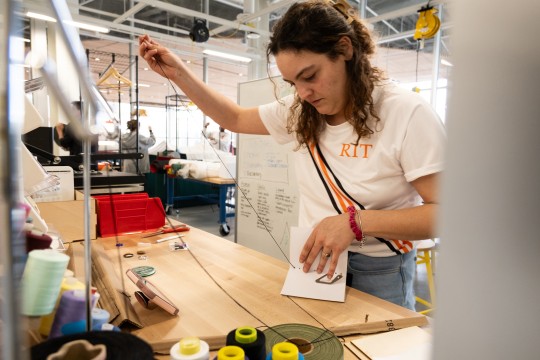
Innovation unleashed: students forge transdisciplinary projects at RIT's a2ru summit
Students leveraged the variety of makerspaces in RIT's brand-new SHED facility to create arts-integrative work responding to a theme of "Play."
-
January 18, 2024
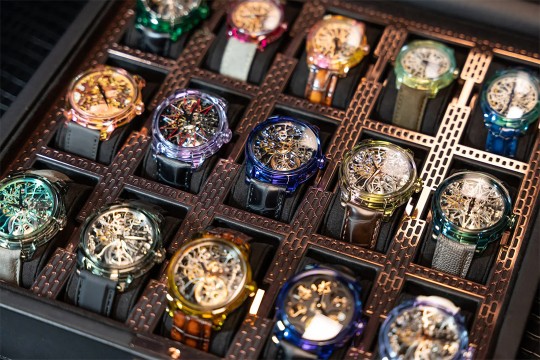
Watches That Can Reflect the Colors of the Rainbow
The New York Times talks to Susan Farnand, associate professor of color science, about how color is perceived. (This content requires a subscription to view.)
Curriculum for 2025-2026 for Color Science Ph.D.
Current Students: See Curriculum Requirements
Students are also interested in
Admissions and Financial Aid
This program is available on-campus only.
| Offered | Admit Term(s) | Application Deadline | STEM Designated |
|---|---|---|---|
| Full‑time | Fall | January 15 priority deadline | Yes |
Full-time study is 9+ semester credit hours. International students requiring a visa to study at the RIT Rochester campus must study full‑time.
Application Details
To be considered for admission to the Color Science Ph.D. program, candidates must fulfill the following requirements:
- Learn tips to apply for a doctoral program and then complete a graduate application.
- Submit copies of official transcript(s) (in English) of all previously completed undergraduate and graduate course work, including any transfer credit earned.
- Hold a baccalaureate degree (or US equivalent) from an accredited university or college in science, engineering, or computer science. A minimum cumulative GPA of 3.0 (or equivalent) is recommended.
- Satisfy prerequisite requirements and/or complete foundation courses prior to starting program coursework.
- Submit a current resume or curriculum vitae.
- Submit a statement of purpose for research which will allow the Admissions Committee to learn the most about you as a prospective researcher.
- Submit two letters of recommendation.
- Entrance exam requirements: None
- Submit English language test scores (TOEFL, IELTS, PTE Academic, etc.), if required. Details are below.
English Language Test Scores
International applicants whose native language is not English must submit one of the following official English language test scores. Some international applicants may be considered for an English test requirement waiver.
Duolingo (DET): 140
IELTS: 7.5
LanguageCert Academic: 84
PTE Academic: 76
TOEFL: 100
International students below the minimum requirement may be considered for conditional admission. Deaf and hard-of-hearing test takers with significant hearing loss do not need to take the listening and speaking sections for the TOEFL and IELTS. Each program requires balanced sub-scores when determining an applicant’s need for additional English language courses.
How to Apply Start or Manage Your Application
Cost and Financial Aid
An RIT graduate degree is an investment with lifelong returns. Ph.D. students typically receive full tuition and an RIT Graduate Assistantship that will consist of a research assistantship (stipend) or a teaching assistantship (salary).
Additional Information
Foundation Courses
Candidates without adequate undergraduate work in related sciences must take foundation courses prior to matriculation into the graduate program. A written agreement between the candidate and the program director will identify the required foundation courses. Foundation courses must be completed with an overall B average before a student can matriculate into the graduate program.
The foundation courses, representative of those often required, are as follows: one year of calculus, one year of college physics (with laboratory), one course in computer programming, one course in matrix algebra, one course in statistics, and one course in introductory psychology. Other science courses (with laboratory) might be substituted for physics.
Accreditation
Contact
- Mandie Klingelhoffer
- Senior Assistant Director
- Office of Graduate Admissions
- Enrollment Management
- 585‑475‑5526
- mskecr@rit.edu
- Susan Farnand
- Associate Professor
- Color Science Program
- College of Science
- 585‑475‑4567
- susan.farnand@rit.edu
Integrated Sciences Academy















